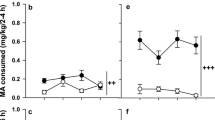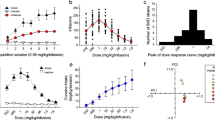Abstract
In an effort to identify genes that may be important for drug-abuse liability, we mapped behavioral quantitative trait loci (bQTL) for sensitivity to the locomotor stimulant effect of methamphetamine (MA) using two mouse lines that were selectively bred for high MA-induced activity (HMACT) or low MA-induced activity (LMACT). We then examined gene expression differences between these lines in the nucleus accumbens, using 20 U74Av2 Affymetrix microarrays and quantitative polymerase chain reaction (qPCR). Expression differences were detected for several genes, including Casein Kinase 1 Epsilon (Csnkle), glutamate receptor, ionotropic, AMPA1 (GluR1), GABA B1 receptor (Gabbr1), and dopamine- and cAMP-regulated phosphoprotein of 32 kDa (Darpp-32). We used the www.WebQTL.org database to identify QTL that regulate the expression of the genes identified by the microarrays (expression QTL; eQTL). This approach identified an eQTL for Csnkle on Chromosome 15 (LOD=3.8) that comapped with a bQTL for the MA stimulation phenotype (LOD=4.5), suggesting that a single allele may cause both traits. The chromosomal region containing this QTL has previously been associated with sensitivity to the stimulant effects of cocaine. These results suggest that selection was associated with (and likely caused) altered gene expression that is partially attributable to different frequencies of gene expression polymorphisms. Combining classical genetics with analysis of whole-genome gene expression and bioinformatic resources provides a powerful method for provisionally identifying genes that influence complex traits. The identified genes provide excellent candidates for future hypothesis-driven studies, translational genetic studies, and pharmacological interventions.



Similar content being viewed by others
References
Agrawal A, Jacobson KC, Prescott CA, Kendler KS (2004) A twin study of personality and illicit drug use and abuse/dependence. Twin Res 7, 72–81
Balfour DJ, Wright AE, Benwell ME, Birrell CE (2000) The putative role of extra-synaptic mesolimbic dopamine in the neurobiology of nicotine dependence. Behav Brain Res 113, 73–83
Bartoletti M, Gubellini C, Ricci F, Gaiardi M (2004) The GABAB agonist baclofen blocks the expression of sensitisation to the locomotor stimulant effect of amphetamine. Behav Pharmacol 15, 397–401
Belknap JK Richards SP, O’Toole LA, Helms ML, Phillips TJ (1997) Short-term selective breeding as a tool for QTL mapping: ethanol preference drinking in mice. Behav Genet 27, 55–66
Belknap JK, Hitzemann R, Crabbe JC, Phillips TJ, Buck KJ, et al. (2001) QTL analysis and genomewide mutagenesis in mice: complementary genetic approaches to the dissection of complex traits. Behav Genet 31, 5–15
Benjamini Y, Hochberg Y (1995) Controlling the false discovery rate: A practical and powerful approach to multiple testing. J Stat Soc 57, 289–300
Bergeson SE, Warren RK, Crabbe JC, Metten P, Erwin VG, et al. (2003) Chromosomal loci influencing chronic alcohol withdrawal severity. Mammal Genome 14, 454–463
Boileau I, Assaad JM, Pihl RO, Benkelfat C, Leyton M, et al. (2003) Alcohol promotes dopamine release in the human nucleus accumbens. Synapse 49, 226–231
Brebner K, Ahn S, Phillips AG (2004) Attenuation of d-amphetamine self-administration by baclofen in the rat: behavioral and neurochemical correlates. Psychopharmacology (Berl) 177, 409–417
Broman KW, Wu H, Sen S, Churchill GA (2003) R/qtl: QTL mapping in experimental crosses. Bioinformatics 19, 889–890
Chesler EJ, Lu L, Wang J, Williams RW, Manly KF (2004) WebQTL: rapid exploratory analysis of gene expression and genetic networks for brain and behavior. Nat Neurosci 7, 485–486
Churchill GA, Doerge RW (1994) Empirical threshold values for quantitative trait mapping. Genetics 138, 963–971
Complex Trait Consortium (2003) The nature and identification of quantitative trait loci: a community’s view. Nat Rev Genet 4, 911–916
Cousins MS, Roberts DC, de Wit H (2002) GABA(B) receptor agonists for the treatment of drug addiction: a review of recent findings. Drug Alcohol Depend 65, 209–220
David HN, Sissaoui K, Abraini JH (2004) Modulation of the locomotor responses induced by D(1)-like and D(2)-like dopamine receptor agonists and D-amphetamine by NMDA and non-NMDA glutamate receptor agonists and antagonists in the core of the rat nucleus accumbens. Neuropharmacology 46, 179–191
Desdouits F, Cohen D, Nairn AC, Greengard P, Girault JA (1995) Phosphorylation of DARPP-32 a dopamine- and cAMP-regulated phosphoprotein, by casein kinase I in vitro and in vivo. J Biol Chem 270, 8772–8778
Di Chiara G (2002) Nucleus accumbens shell and core dopamine: differential role in behavior and addiction. Behav Brain Res 137, 75–114
Di Chiara G, Imperato A (1988) Drugs abused by humans preferentially increase synaptic dopamine concentrations in the mesolimbic system of freely moving rats. Proc Natl Acad Sci USA 85, 5274–5278
Di Ciano P, Everitt BJ (2003) The GABA(B) receptor agonist baclofen attenuates cocaine- and heroin-seeking behavior by rats. Neuropsychopharmacology 28, 510–518
Fadda P, Scherma M, Fresu A, Collu M, Fratta W (2003) Baclofen antagonizes nicotine-, cocaine-, and morphine-induced dopamine release in the nucleus accumbens of rat. Synapse 50, 1–6
Fehr C, Shirley RL, Belknap JK, Crabbe JC, Buck KJ (2002) Congenic mapping of alcohol and pentobarbital withdrawal liability loci to a < 1 centimorgan interval of murine chromosome 4: identification of Mpdz as a candidate gene. J Neurosci 22, 3730–3738
Glazier AM, Nadeau JH, Airman TJ (2002) Finding genes that underlie complex traits. Science 298, 2345–2349
Greengard P (2001) The neurobiology of slow synaptic transmission. Science 294, 1024–1030
Grisel JE, Belknap JK, O’Toole LA, Helms ML, Charlotte WD, et al. (1997) Quantitative trait loci affecting methamphetamine responses in B×D recombinant inbred strains. J Neurosci 17, 745–754
Gross C, Zhuang X, Stark K, Ramboz S, Oosting R, et al. (2002) Serotoninl A receptor acts during development to establish normal anxiety-like behaviour in the adult. Nature 416, 396–400
Hitzemann R, Malmanger B, Reed C, Lawler M, Hitzemann B, et al. (2003) A strategy for the integration of QTL, gene expression, and sequence analyses. Mamm Genome 14, 733–747
Hitzemann R, Reed C, Malmanger B, Lawler M, Hitzemann B, et al. (2004) On the integration of alcohol-related quantitative trait loci and gene expression analyses. Alcohol Clin Exp Res 28, 1437–1448
Irizarry RA, Bolstad BM, Collin F, Cope LM, Hobbs B, et al. (2003) Summaries of Affymetrix GeneChip probe level data. Nucleic Acids Res 31, e15
Jones BC, Tarantino LM, Rodriguez LA, Reed CL, McClearn GE, et al. (1999) Quantitative-trait loci analysis of cocaine-related behaviours and neurochemistry. Pharmacogenetics 9, 607–617
Kamens HM, Burkhart–Kasch S, McKinnon CS, Li N, Reed C, Phillips TJ (2005) Sensitivity to psychostimulants in mice bred for high and low stimulation to methamphetamine. Genes Brain Behav 4, 110–125
Kendler KS, Jacobson KC, Prescott CA, Neale MC (2003) Specificity of genetic and environmental risk factors for use and abuse/dependence of cannabis, cocaine, hallucinogens, sedatives, stimulants, and opiates in male twins. Am J Psychiatry 160, 687–695
Kim JH, Creekmore E, Vezina P (2003) Microinjection of CART peptide 55-102 into the nucleus accumbens blocks amphetamine-induced locomotion. Neuropeptides 37, 369–373
Lander ES, Botstein D (1989) Mapping mendelian factors underlying quantitative traits using RFLP linkage maps. Genetics 121, 185–199
Lecca D, Piras G, Driscoll P, Giorgi O, Corda MG (2004) A differential activation of dopamine output in the shell and core of the nucleus accumbens is associated with the motor responses to addictive drugs: a brain dialysis study in Roman high- and low-avoidance rats. Neuropharmacology 46, 688–699
Li C, Wong WH (2003) DNA-Chip analyzer (dChip). In The Analysis of Gene Expression Data: Methods and Software, Parmigiani ES, Garrett EA, Irizarry RA, Seger SL (eds.) New York: Springer), pp 120–141
Li T-K, Lumeng L, McBride WJ, Murphy JM (1987) Rodent lines selected for factors affecting alcohol consumption. Alcohol Alcohol Suppl 1, 91–96
Liang T, Spence J, Liu L, Strother WN, Chang HW, et al. (2003) alpha-Synuclein maps to a quantitative trait locus for alcohol preference and is differentially expressed in alcohol-preferring and -nonpreferring rats. Proc Natl Acad Sci USA 100, 4690–4695
Mackay TF (2001) The genetic architecture of quantitative traits. Annu Rev Genet 35, 303–339
Mitchison A (1997) Partitioning of genetic variation between regulatory and coding gene segments: the predominance of software variation in genes encoding introvert proteins. Immunogenetics 46, 46–52
Niculescu AB 3rd, Segal DS, Kuczenski R, Barrett T, Hauger RL, et al. (2000) Identifying a series of candidate genes for mania and psychosis: a convergent functional genomics approach. Physiol Genomics 4, 83–91
Ogden CA, Rich ME, Schork NJ, Paulus MP, Geyer MA, et al. (2004) Candidate genes, pathways and mechanisms for bipolar (manic-depressive) and related disorders: an expanded convergent functional genomics approach. Mol Psychiatry 9, 1007–1029
Palmer AA, Phillips TJ (2002) Quantitative trait loci (QTL) mapping in mice. InMethods in alcohol-related neuroscience research, Liu Y, Lovinger DM, (eds.) (Boca Raton, FL: CRC Press), pp 1–30
Palmer AA, Low MJ, Grandy DK, Phillips TJ (2003) Effects of a Drd2 deletion mutation on ethanol-induced locomotor stimulation and sensitization suggest a role for epistasis. Behav Genet 33, 311–324
Pavlidis P, Noble WS (2001) Analysis of strain and regional variation in gene expression in mouse brain. Genome Biol 2, RESEARCH0042
Peng X, Wood CL, Blalock EM, Chen KG, Landfield PW, et al. (2003) Statistical implications of pooling RNA samples for microarray experiments. BMC Bioinformatics 4, 26
Phillips TJ, Belknap JK, Hitzemann RJ, Buck KJ, Cunningham CL, et al. (2002) Harnessing the mouse to unravel the genetics of human disease. Genes Brain Behav 1, 14–26
Phillis BD, Ong J, White JM, Bonnielle C (2001) Modification of d-amphetamine-induced responses by baclofen in rats. Psychopharmacology 153, 277–284
Schadt EE, Monks SA, Drake TA, Lusis AJ, Che N, et al. (2003) Genetics of gene expression surveyed in maize, mouse and man. Nature 422, 297–302
Sellings LH, Clarke PB (2003) Segregation of amphetamine reward and locomotor stimulation between nucleus accumbens medial shell and core. J Neurosci 23, 6295–6303
Shirley RL, Walter NA, Reilly MT, Fehr C, Buck KJ (2004) Mpdz is a quantitative trait gene for drug withdrawal seizures. Nat Neurosci 7, 699–700
Storey JD, Tibshirani R (2003) Statistical significance for genome-wide experiments. Proc Natl Acad Sci USA 100, 9440–9445
Suto N, Tanabe LM, Austin JD, Creekmore E, Pham CT, Vezina P (2004) Previous exposure to psychostimulants enhances the reinstatement of cocaine seeking by nucleus accumbens AMPA. Neuropsychopharmacology 29, 2149–2159
Tabakoff B, Bhave SV, Hoffman PL (2003) Selective breeding, quantitative trait locus analysis, and gene arrays identify candidate genes for complex drug-related behaviors. J Neurosci 23, 4491–4498
Uhl GR, Elmer G, Labuda M, Pickens RW (1995) Genetic influences in drug abuse. In Psychopharmacology: The Fourth Generation of Progress, Bloom FE, Kupfer F (eds.) (New York: Raven Press), pp 1793–1806
Vetulani J (2001) Drug addiction. Part II. Neurobiology of addiction. Pol J Pharmacol 53, 303–317
Wayne ML, McIntyre LM (2002) Combining mapping and arraying: An approach to candidate gene identification. Proc Natl Acad Sci USA 99, 14903–14906
Wolf ME, Mangiavacchi S, Sun X (2003) Mechanisms by which dopamine receptors may influence synaptic plasticity. Ann NY Acad Sci 1003, 241–249
Acknowledgments
This work was supported by a generous gift from Judith P. Sultzberger, MD, NIH grants DA10913, AA07468, and MH70933, the National Association for Research on Schizophrenia and Depression, and grants from the Department of Veterans Affairs.
Author information
Authors and Affiliations
Corresponding author
Rights and permissions
About this article
Cite this article
Palmer, A.A., Verbitsky, M., Suresh, R. et al. Gene expression differences in mice divergently selected for methamphetamine sensitivity. Mamm Genome 16, 291–305 (2005). https://doi.org/10.1007/s00335-004-2451-8
Received:
Accepted:
Issue Date:
DOI: https://doi.org/10.1007/s00335-004-2451-8




